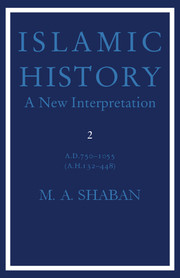Book contents
- Frontmatter
- Contents
- Acknowledgements
- Preface
- 1 The founding of the ʿAbbāsid regime
- 2 Towards a civil war
- 3 Dissolution under a new regime
- 4 The origins of the iqṭāʿ
- 5 Regional economic conflicts
- 6 The breakdown of the central government (I)
- 7 The breakdown of the central government (II)
- 8 The Būyid confederacy
- 9 The Fātimids
- Works cited
- Index
3 - Dissolution under a new regime
Published online by Cambridge University Press: 05 June 2012
- Frontmatter
- Contents
- Acknowledgements
- Preface
- 1 The founding of the ʿAbbāsid regime
- 2 Towards a civil war
- 3 Dissolution under a new regime
- 4 The origins of the iqṭāʿ
- 5 Regional economic conflicts
- 6 The breakdown of the central government (I)
- 7 The breakdown of the central government (II)
- 8 The Būyid confederacy
- 9 The Fātimids
- Works cited
- Index
Summary
In previous civil wars fighting had been limited to protagonists whose interests had been directly involved, and on the whole other sections of the population had chosen to remain out of the struggle, even when their sympathies had been with one party or the other. In this civil war, although the opponents were clearly identified, almost every section of the population in every region became involved and the prolonged struggle spread to all corners of the empire. The abnāʾ were fighting a determined battle to conserve their declining status in the ʿAbbāsid regime, while the Easterners were struggling to consolidate the privileged new position created by their active participation in support of the wider interests of the empire. As Muslims and members of the army they took strong exception to being pushed aside by the abnāʾ, especially when these were not fulfilling their military responsibilities. The latter were determinedly opposed to any change which would give the Easterners a privileged place in the structure of the empire. Every group in the empire with vested interests that were threatened by change actively supported the abnāʾ, while every group that aspired to change sided with the Easterners. This situation created two opposing blocs, one reactionary, symbolised by the abnāʾ; the other progressive and represented by the Easterners. The problem was that while the reactionaries knew exactly what they wanted, the progressives had nothing in common beyond their desire to see the abnāʾ brought to their knees.
- Type
- Chapter
- Information
- Islamic HistoryA New Interpretation, pp. 41 - 70Publisher: Cambridge University PressPrint publication year: 1976



